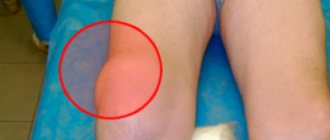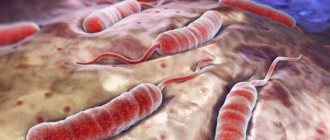Dyshidrosis, or dyshidrotic eczema, is a skin disease that is localized primarily on the hands and feet.
Eczema is not considered a contagious disease and does not pose a danger to others, but it is symptomatic and extremely unpleasant.
The treatment tactics for the disease are selected comprehensively. This disease, unfortunately, occurs in phases with periods of relief and relapses (returns). Even competent and professional treatment does not guarantee periodic cases of the disease returning.
What is the disease?
Dyshidrosis is a skin disease of the hands and feet that affects the sweat glands.
Other names: pompholyx, crowberry.
Dyshidrosis manifests itself as itchy rashes in the form of groups of small watery blisters. The disease is of an allergic nature and often occurs against the background of other skin diseases.
There is seasonality: symptoms of dyshidrosis are more often observed in spring and autumn.
Important:
Dyshidrosis is not transmitted from person to person.
Medicines
Photo: med-look.ru
A skin pathology accompanied by the appearance of blisters with fluid is called dyshidrosis or pompholyx. The disease is painful with constant itching of the hands and feet. The skin disease is not contagious and is mostly chronic. Therefore, patients register at the dispensary and are observed by a doctor. Treatment of dyshidrosis is rather symptomatic, aimed at eliminating external manifestations on the skin. It must be comprehensive, only in this case there is a chance of recovery. Therapy is prescribed by a doctor, taking into account the nature of the disease and its stage.
Drugs to combat skin disease
Complex treatment of the disease involves undergoing various types of therapy. At the same time, the patient must take medications prescribed by the attending physician. The patient is prescribed:
- anti-inflammatory drugs;
- antihistamines;
- hyposensitizing drugs;
- glucocorticosteroid drugs (in severe forms).
The affected areas of the skin are treated with various antipruritic, anti-inflammatory, antiallergic ointments and creams. These drugs include:
- triderm;
- diprosalic;
- advantan;
- zinc ointment;
- salicylic ointment.
Ointments are prescribed for the normal course of the disease, its dry form, secondary manifestation, and at the exfoliation stage.
Triderm for dyshidrosis
The drug is available in the form of a cream or ointment. It is an excellent antimicrobial agent. The antibiotic gentamicin included in the composition is absorbed into problem areas of the skin when applied. It has a systemic effect. The drug is highly effective for all forms of eczema, dermatitis, lichen, and dermatomycosis.
The cream is applied to the surface of the affected areas twice a day in the morning and evening. Triderm should be used daily as prescribed. This medicine has its contraindications, so you should carefully read the instructions before use.
Diprosalik
Like Triderm, Diprosalik is a combination drug. It contains substances such as salicylic acid and betamethasone dipropionate. The ointment has an anti-inflammatory, antipruritic, vasoconstrictor effect. Prescribed for people of any age group, starting from two years. The ointment is used twice a day in the morning and evening. Apply the drug to the affected areas in a thin layer. Diprosalic is not recommended for use if there is increased sensitivity of the body to any substance included in the composition. Reviews from patients using Diprosalic for dyshidrosis indicate that the medicine copes well with the disease in the initial stages of its manifestation.
Advantan for dyshidrosis
Itching, pain and irritation are effectively suppressed by Advantan. Available in the form of ointment and cream. Apply externally once a day. The course of treatment is no more than 14 days. Medical practice shows that Advantan is widely used in dermatology for the treatment of severe forms of pathologies. The ointment is contraindicated in children under 4 years of age. The instructions indicate precautions and contraindications that should be strictly observed.
Zinc ointment
Zinc ointment is an anti-inflammatory agent that has been known since ancient times. This is a simple and effective remedy for many inflammatory skin diseases. The ointment contains zinc oxide. You can purchase the drug at a pharmacy without a doctor's prescription.
The effect of zinc ointment for dyshidrosis is aimed at reducing irritation, drying out skin areas, and reducing inflammation. Apply to damaged skin two to three times a day with light movements. Before use, you must read the instructions for use. The medicine has no contraindications, but long-term use can cause allergic reactions.
Salicylic ointment
It is used for the dry form of dyshidrosis or the exfoliation stage. Has anti-inflammatory and antiseptic effects. The correct effect in treatment is achieved when used according to the instructions. Ointment for dyshidrosis is applied to the affected skin 1-2 times a day. To improve the result, apply a sterile napkin on top. The course of use of the drug depends on the stage of the disease, but it should not exceed 21 days. Salicylic ointment has contraindications, so you need to read the instructions.
It is not recommended to treat dyshidrosis on your own. Each drug should be selected by a dermatologist. The doctor prescribes medicine depending on the stage of the disease and its course.
Types of dyshidrosis
Based on the severity of the clinical picture and the depth of the lesion, three types of the disease are distinguished.
True dyshidrosis
True dyshidrosis affects only the palms and the area at the base of the fingers. The bubbles appear simultaneously and do not grow further. At the beginning of the disease, redness, severe itching and swelling of the skin appear.
Dyshidrotic eczema
The progressive appearance of blisters on the arms and legs indicates dyshidrotic eczema. The blisters may grow and multiply throughout the course of the disease. In addition to the manifestation of the main symptoms, the disease can affect the general condition. Fever, headache, enlarged lymph nodes are warning signs.
Important:
Dyshidrotic eczema is a complex type of dyshidrosis, often developing into a chronic form.
Dry lamellar dyshidrosis
If the skin peels and comes off in “flakes”, but there are no bubbles, you have dry lamellar dyshidrosis. This is a mild form of this disease, accompanied by only slight itching. It is not recommended to scratch or rip off the affected skin.
Why is dyshidrotic eczema dangerous?
This disease is not capable of leading to death, but it is quite capable of complicating a person’s life.
Most people perceive any skin disease as contagious, therefore they will avoid close contacts, especially physical ones, which causes a very painful reaction in the sick person - he begins to feel like an outcast, his self-esteem decreases, in short, his psychological state worsens. This is one of the reasons why you need to urgently consult a dermatologist.
First of all, it is necessary to make a correct diagnosis, and here you cannot do without an experienced dermatologist - only he, after a thorough visual examination and based on the results of laboratory tests, will be able to exclude diseases with similar manifestations, such as fungal infections of the skin, allergic reactions, dermatitis of other etiologies .
This requires a detailed blood test, a coprogram and a stool test for helminths (worms). Another important diagnostic criterion is the frequency of bubbles.
The disease itself is extremely unpleasant due to itching and burning on the affected skin, but it can have much more serious consequences if an infection gets into the injured areas of the skin due to scratching. The contents of the bubbles acquire a yellow color and become purulent.
There have been cases of dyshidrosis developing into a severe form of eczema, which, in addition to peeling of the palms, is characterized by the appearance of cracks and purulent discharge on the skin, which will require long-term treatment.
That is why it is necessary to avoid scratching and injuring the skin as much as possible, so as not to cause re-infection.
If dyshidrosis is severe, blisters can form very close to the nail plate and even under it. As a result, paronychia occurs - lifting of the nail plate with the formation of a kind of ridge or pronounced swelling at the base of the nail.
If adequate and effective treatment is not started in a timely manner, diseases such as panaritium (folklore hair, an acute purulent inflammatory disease of the tissues on the fingers) or lymphangitis (inflammation of the lymphatic vessels) may occur.
Lymphangitis/Felon
Particular attention should be paid to the appearance of signs of dyshidrosis during pregnancy. In this case, treatment is complicated by the possible negative impact of medications on the development of the fetus, so it is often carried out locally, using traditional medicine methods.
In newborns and infants receiving breast milk, the appearance of symptoms of the disease is most often due to poor nutrition of the mother.
After consulting with a doctor, she will have to reconsider her diet and exclude foods that provoke these symptoms.
Symptoms of dyshidrosis
Symptoms largely depend on the form of dyshidrosis, but if we describe the general clinical picture, we can identify the main symptoms for each stage of the course of dyshidrosis:
- skin redness;
- swelling of the affected area;
- itching preceding the appearance of blisters;
- thickening of the skin before the rash;
- the appearance of groups of small watery bubbles;
- formation of a crust at the site of the blisters after 2-3 days;
- crust rejection;
- peeling and peeling of the skin.
Important:
dyshidrosis affects only the feet and hands. The manifestation of symptoms in other places with dyshidrosis is impossible.
Possible complications
When scratching or opening the rash on your own, there is a high risk of pathogenic microorganisms getting inside. This leads to an inflammatory process: the blisters turn into pustules. The liquid inside them loses its transparency, acquiring a yellowish color. The discomfort intensifies, severe swelling appears. In some cases, the patient experiences an increase in body temperature.
Other complications of hand dyshidrosis include panaritium and lymphangitis: purulent inflammation of the finger and lymphatic vessel, respectively. In the latter case, a painful cord forms under the skin.
Diagnosis of dyshidrosis
Typically, dyshidrosis is diagnosed by a doctor visually, without the use of special techniques. In some cases, difficulties arise in determining the disease due to the similarity of dyshidrosis with fungal skin infections. Tests may also be required to identify the root cause of the disease.
To confirm the diagnosis and choose the optimal treatment, you may need:
- analysis for fungal infections,
- immunogram,
- gastroscopy,
- allergy test.
Make an appointment
Causes
Skin dyshidrosis is caused by internal and external causes. Experts most often refer to the allergic or neurological nature of the disease.
This condition indicates serious disorders occurring in the body, affecting its most important organs and systems.
Damage to the skin of the hands is associated with a complex of various factors and causes, endogenous and exogenous .
What can cause dyshidrosis of the limbs:
- weakened immunity, state of immunodeficiency;
- chronic diseases;
- tendency to an allergic reaction;
- metabolic disease;
- changes in hormonal levels;
- severe psycho-emotional shock;
- mental and physical fatigue.
Treatment methods for dyshidrosis
Medicines
External use:
- antiseptics (disinfection) – 2% boric acid, brilliant green, Chlorhexidine, Miramistin;
- inhibitors (to suppress immune reactions) – Tacrolimus, Protopic, Elidel;
- anti-inflammatory (for swelling, redness, itching) - Advantan, zinc ointment, Mometasone, Flucinar.
Oral administration:
- antihistamines (relief of allergy symptoms) - Cetirizine, Suprastin, Loratadine, Tavegil;
- glucocorticosteroids (in severe form) – Prednisolone, Hydrocortisone;
- sedatives (calming) – Afobazol, Lazeya, valerian extract.
Therapy
- Electrophoresis – for deep effects of drugs.
- UV therapy – for disinfection.
- Ozone therapy – for disinfection (no scientific evidence of effectiveness).
- Laser therapy – for rapid healing of opened blisters.
Folk remedies
- Sage and chamomile have an antibacterial effect.
- Eucalyptus disinfects the skin and relieves pain.
- Cabbage and raw potatoes relieve swelling and relieve pain.
- An ointment made from butter and currant branches reduces itching.
Folk remedies
They are used as independent remedies for minor damage to the epidermis or as part of complex therapy. They make medicinal baths or wipe the skin.
- Baking soda. Is a powerful antiseptic. Quickly relieves itching and stops the inflammatory process. For 500 ml of warm water, 2 teaspoons of the product are required. Place your arms and legs in the water and hold for 20 minutes. Wipe with napkins, apply ointment, cream.
- Herbal collection. Mix oak bark, string, and sage in equal proportions. Fill with water, boil for 10 minutes over low heat, allow to cool to a comfortable temperature.
- Lemon. Squeeze the juice of one lemon into 500 ml of warm water or add 0.5 teaspoons of acid. Used for wiping, making a bath.
Laundry soap, tar soap, and olive oil will help relieve itching, irritation, and redness.
Diet for dyshidrosis
If you have dyshidrosis, you must adhere to a diet of foods that are neutral for allergy sufferers.
It is recommended to exclude:
- salt, spices, herbs;
- alcoholic drinks;
- caffeine;
- nuts;
- honey;
- all derivatives of cocoa beans;
- citrus;
- milk;
- fish;
- eggs;
- tomatoes, carrots;
- berries (especially cherries, strawberries, raspberries);
- melons
It is worth focusing on:
- porridge;
- dairy products;
- vegetable salads with oil dressing.
Why does skin disease occur?
Dyshidrotic eczema is another equally popular name for the disease in question. Most often it develops against the background of psycho-emotional disorders, stress, and prolonged experiences. The ideal background for the development of skin dyshidrosis is a weakened immune system, which is often caused by pathologies of the gastrointestinal tract and fungal infections. To achieve a positive result in the treatment of this disease, the use of medications alone will not be enough. The patient will have to make drastic changes in their lifestyle - then they will be able to achieve success in treatment.
Skin disease in children
Skin dyshidrosis in children responds well to treatment. Most often, the disease is diagnosed at an early age, before three years. If you start treatment in a timely manner and follow all medical recommendations, the disease will recede. But no doctor can guarantee that the disease will not return at an older age.
In children, the cause of the disease in most cases is an allergic reaction, so when symptoms of the disease appear, a comprehensive examination by a dermatologist and allergist is mandatory. Drugs for the treatment of dyshidrosis are selected depending on the age of the child and the severity of the disease.
Zinc-based ointments
One of the common remedies used in the treatment of skin diseases is zinc ointment. It is difficult to list what this remedy helps with. The fact is that this hypoallergenic product has a drying, adsorbing, astringent and disinfecting effect, reduces exudation and weeping, and relieves local manifestations of inflammation. Here's what zinc ointment helps with, in addition to dyshidrosis:
- diaper rash;
- prickly heat;
- skin ulcers;
- dermatitis;
- herpes;
- streptoderma;
- burns;
- bedsores.
The pharmacy sells zinc-based external preparations such as Valiskin, Desitin, Sudocrem, Tsindol, and Zinc paste. Products based on ichthyol, birch tar, and salicylic acid also have similar properties.
Preparations for external use
To relieve severe inflammation on the affected skin, the patient is prescribed hormonal ointments “Ftorokort”, “Triderm”, “Polcortolon”, “Elocom”, “Laticort”. The course of treatment with external steroid agents usually does not exceed a week, after which the patient is transferred to non-hormonal formulations. If an infection has attached to the affected area, treatment is supplemented with hand ointment with an antibiotic (tetracycline ointment, Levomekol). On the legs, dyshidrosis is more often complicated by a fungus, therefore, along with anti-inflammatory compounds, the patient is prescribed antifungal agents (Lamicon, Amiklon, Exoderil).








